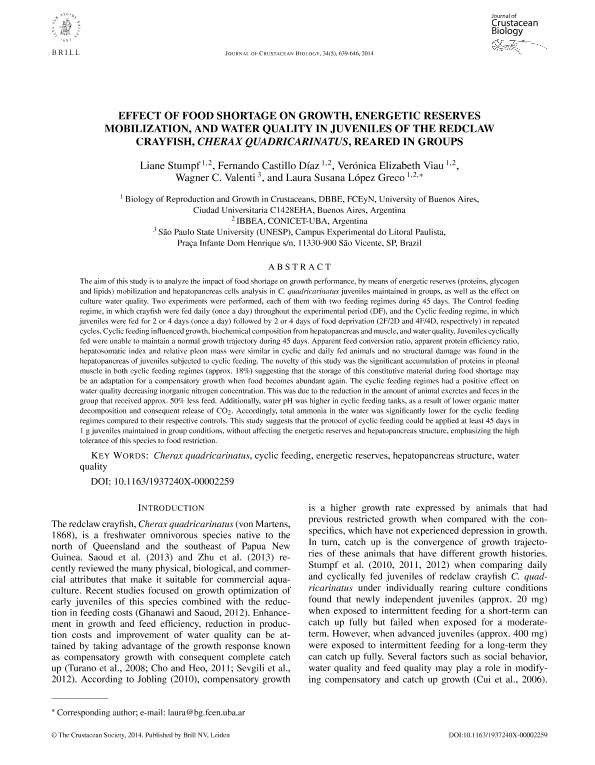Artículo
Effect of Food Shortage on Growth, Energetic Reserves Mobilization, and Water Quality in Juveniles of the Redclaw Crayfish, Cherax Quadricarinatus, Reared in Groups
Stumpf, Liane ; Castillo Díaz, Fernando
; Castillo Díaz, Fernando ; Viau, Veronica Elizabeth
; Viau, Veronica Elizabeth ; Valenti, Wagner C.; Lopez, Laura Susana
; Valenti, Wagner C.; Lopez, Laura Susana
 ; Castillo Díaz, Fernando
; Castillo Díaz, Fernando ; Viau, Veronica Elizabeth
; Viau, Veronica Elizabeth ; Valenti, Wagner C.; Lopez, Laura Susana
; Valenti, Wagner C.; Lopez, Laura Susana
Fecha de publicación:
09/2014
Editorial:
Oxford University Press
Revista:
Journal of Crustacean Biology
ISSN:
0278-0372
Idioma:
Inglés
Tipo de recurso:
Artículo publicado
Clasificación temática:
Resumen
The aim of this study is to analyze the impact of food shortage on growth performance, by means 24 of energetic reserves (proteins, glycogen and lipids) mobilization and hepatopancreas cells 25 analysis in C. quadricarinatus juveniles maintained in groups, as well as the effect on culture 26 water quality. Two experiments were performed, each of them with two feeding regimes during 27 45 days. The Control feeding regime, in which crayfish were fed daily (once a day) throughout 28 the experimental period (DF), and the Cyclic feeding regime, in which juveniles were fed for 2 or 29 4 days (once a day) followed by 2 or 4 days of food deprivation (2F/2D and 4F/4D, respectively) 30 in repeated cycles. Cyclic feeding influenced growth, biochemical composition from 31 hepatopancreas and muscle, and water quality. Juveniles cyclically fed were unable to maintain a 32 normal growth trajectory during 45 days. Apparent feed conversion ratio, apparent protein 33 efficiency ratio, hepatosomatic index and relative pleon mass were similar in cyclic and daily fed 34 animals and no structural damage was found in the hepatopancreas of juveniles subjected to 35 cyclic feeding. The novelty of this study was the significant accumulation of proteins in pleonal 36 muscle in both cyclic feeding regimes (~18%) suggesting that the storage of this constitutive 37 material during food shortage may be an adaptation for a compensatory growth when food 38 becomes abundant again. The cyclic feeding regimes had a positive effect on water quality 39 decreasing inorganic nitrogen concentration. This was due to the reduction in the amount of 40 animal excretes and feces in the group that received ~50% less feed. Additionally, water pH was 41 higher in cyclic feeding tanks, as a result of lower organic matter decomposition and consequent 42 release of CO2. Accordingly, total ammonia in the water was significantly lower for the cyclic 43 feeding regimes compared to their respective controls. This study suggests that the protocol of 44 cyclic feeding could be applied at least 45 days in 1 g juveniles maintained in group conditions, 45 3 without affecting the energetic reserves and hepatopancreas structure, emphasizing the high 46 tolerance of this species to food restriction.
Archivos asociados
Licencia
Identificadores
Colecciones
Articulos(IBBEA)
Articulos de INSTITUTO DE BIODIVERSIDAD Y BIOLOGIA EXPERIMENTAL Y APLICADA
Articulos de INSTITUTO DE BIODIVERSIDAD Y BIOLOGIA EXPERIMENTAL Y APLICADA
Articulos(IBCN)
Articulos de INST.DE BIOLO.CEL.Y NEURCS."PROF.E.DE ROBERTIS"
Articulos de INST.DE BIOLO.CEL.Y NEURCS."PROF.E.DE ROBERTIS"
Citación
Lopez, Laura Susana; Valenti, Wagner C.; Viau, Veronica Elizabeth; Castillo Díaz, Fernando; Stumpf, Liane; Effect of Food Shortage on Growth, Energetic Reserves Mobilization, and Water Quality in Juveniles of the Redclaw Crayfish, Cherax Quadricarinatus, Reared in Groups ; Oxford University Press; Journal of Crustacean Biology; 34; 5; 9-2014; 639-646
Compartir
Altmétricas



